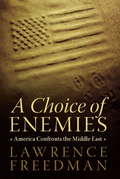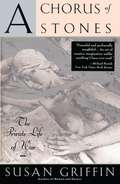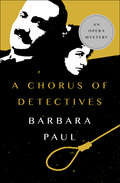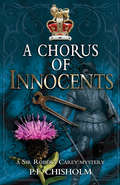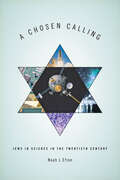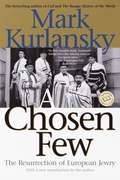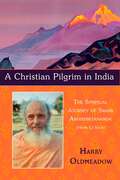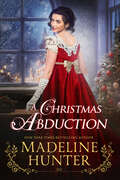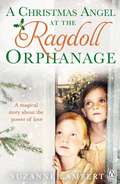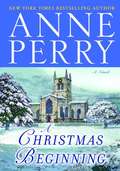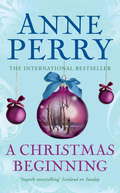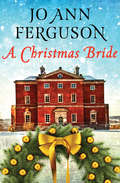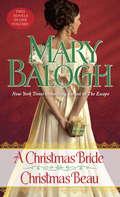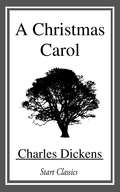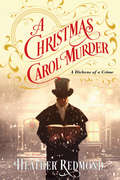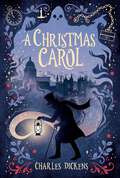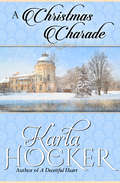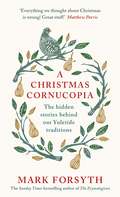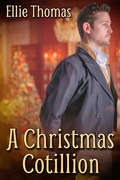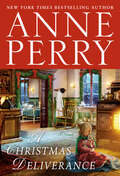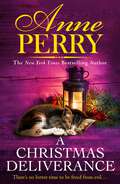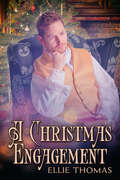- Table View
- List View
A Choice of Enemies: America Confronts the Middle East
by Lawrence FreedmanIt is in the Middle East that the U. S. has been made to confront its attitudes on the use of force, the role of allies, and international law. The history of the U. S. in the Middle East, then, becomes an especially revealing mirror on America's view of its role in the wider world. In this wise, objective, and illuminating history, Lawrence Freedman shows how three key events in 1978-79 helped establish the foundations for U. S. involvement in the Middle East that would last for thirty years, without offering any straightforward or bloodless exit options: the Camp David summit leading to the Israel-Egypt Treaty; the Iranian Islamic revolution leading to the Shah's departure followed by the hostage crisis; and the socialist revolution in Afghanistan, resulting in the doomed Soviet intervention. Freedman makes clear how America's strategic choices in those and subsequent crises led us to where we are today. A Choice of Enemies is essential reading for anyone concerned with the complex politics of the region or with the future of American foreign policy.
A Choice of Secrets (A Dark Glass Novel #4)
by Barb HendeeEver since raiders from the north began attacking villages, Lady Nicole Montagna has known that defending her people would come at a cost. The betrothal of her sister Chloe to a neighboring lord seems the perfect solution, forging a powerful alliance. But shortly before the wedding, Nicole is shocked to discover that her sister is with child—and not by her husband-to-be. Now she must make a choice. She has just hours to decide . . . ~Should she tell her soldier brother—who will take swift, ruthless action to ensure the family’s safety? ~Should she hold her tongue, let her sister deceive her husband into believing the child is his—and then hope Chloe can get away with the lie? ~Should she tell her family, hoping they will know the right thing to do? With the help of a magic mirror, Nicole lives out each path, fighting to protect herself and those she loves with the weapons she has: wits, herbs, and fortitude. But no matter her cleverness, neither she nor her family can escape unscathed—for there are repercussions she could never have foreseen, involving her own heart . . . A CHOICE OF SECRETS New York Times bestselling author Barb Hendee spins a tale of intrigue, integrity, and the bonds of love and loyalty as one young woman finds her place in a turbulent world . . .
A Chorus Of Stones
by Susan GriffinWritten by one of America's most innovative and articulate feminists, this book illustrates how childhood experience, gender and sexuality, private aspirations, and public personae all assume undeniable roles in the causes and effects of war.
A Chorus of Detectives (The Opera Mysteries #3)
by Barbara PaulThe stars of the Metropolitan Opera search for a crazed killer who plans to bring the company down. They find the tenor dangling from a water pipe, hanging by his own suspenders. His corpse is still warm. Naturally, the opera&’s manager doesn&’t stop the production. A dead chorus tenor isn&’t enough to close them down, and the show must go on. But there are 139 singers left in the chorus—and someone intends to kill them all. Poisoning, strangling, and rigged trapdoors are just a few of the methods at the killer&’s disposal. The opera posts guards backstage, but the slayings continue, forcing the Met&’s two fading stars, Enrico Caruso and Geraldine Farrar, to band together and save the opera they love so much. A Chorus of Detectives is the 3rd book in the Opera Mysteries, but you may enjoy reading the series in any order.
A Chorus of Innocents: A Sir Robert Carey Mystery (Sir Robert Carey Series #7)
by P F ChisholmThis time out, it's Sir Robert Carey's unhappily married love, Elizabeth, who solves a murder steeped in political intrigue. Lady Elizabeth Widdrington is buying two horses that had most likely been stolen in Scotland when her friend Poppy Burn arrives in a terrible state. <P><P>Far gone in pregnancy, the hysterical Poppy reveals that her husband, James, a minister over the Scottish border in Wendron, was murdered by two strangers who also raped her. <P><P> Despite the fact that Elizabeth knows her cruel and indifferent husband, Sir Henry, will be furious, she crosses the border herself, accompanied by young Henry and several Widdrington cousins, to see James properly buried. <P><P>At Poppy's house she finds the strong-willed dowager Lady Hume of Norland, who's perhaps a little mad, doing all in her power to keep her beloved grandson, Hughie, out of the hands of Lord Spynie, the homosexual favorite of King James VI of Scotland. Although the border country is rife with stealing, murder, and clan rivalries, Elizabeth can't help but think that some more intimate intrigue is responsible for the death of a popular minister who was running a school for boys. <P><P>She soon finds herself in trouble with several factions but continues to hunt for information. In the meantime, Sir Robert Carey, suffering from a toothache and in search of help, runs into the barber surgeon, Mr. Anricks, recently returned from helping Elizabeth in Wendron. <P><P>Once Anricks, who's more than he seems, joins with Elizabeth and Carey, a dangerous hunt can be brought to a satisfying conclusion. <P><P>One of Chisholm's best Elizabethan mysteries (An Air of Treason, 2014, etc.), combining all the historical information readers have come to expect with a swiftly moving story featuring a strong woman whose romantic aspirations have yet to be fulfilled.
A Chosen Calling: Jews in Science in the Twentieth Century (Medicine, Science, and Religion in Historical Context)
by Noah J. EfronQuestions traditional explanations for Jewish excellence in science in the United States, the Soviet Union, and Palestine in the twentieth century.Scholars have struggled for decades to explain why Jews have succeeded extravagantly in modern science. A variety of controversial theories—from such intellects as C. P. Snow, Norbert Wiener, and Nathaniel Weyl—have been promoted. Snow hypothesized an evolved genetic predisposition to scientific success. Wiener suggested that the breeding habits of Jews sustained hereditary qualities conducive for learning. Economist and eugenicist Weyl attributed Jewish intellectual eminence to "seventeen centuries of breeding for scholars."Rejecting the idea that Jews have done well in science because of uniquely Jewish traits, Jewish brains, and Jewish habits of mind, historian of science Noah J. Efron approaches the Jewish affinity for science through the geographic and cultural circumstances of Jews who were compelled to settle in new worlds in the early twentieth century.Seeking relief from religious persecution, millions of Jews resettled in the United States, Palestine, and the Soviet Union, with large concentrations of settlers in New York, Tel Aviv, and Moscow. Science played a large role in the lives and livelihoods of these immigrants: it was a universal force that transcended the arbitrary Old World orders that had long ensured the exclusion of all but a few Jews from the seats of power, wealth, and public esteem. Although the three destinations were far apart geographically, the links among the communities were enduring and spirited. This shared experience—of facing the future in new worlds, both physical and conceptual—provided a generation of Jews with opportunities unlike any their parents and grandparents had known.The tumultuous recent century of Jewish history, which saw both a methodical campaign to blot out Europe's Jews and the inexorable absorption of Western Jews into the societies in which they now live, is illuminated by the place of honor science held in Jewish imaginations. Science was central to their dreams of creating new worlds—welcoming worlds—for a persecuted people.This provocative work will appeal to historians of science as well as scholars of religion, Jewish studies, and Zionism.
A Chosen Exile: A History of Racial Passing in American Life
by Allyson HobbsCountless African Americans have passed as white, leaving behind families and friends, roots and communities. It was, as Allyson Hobbs writes, a chosen exile. This history of passing explores the possibilities, challenges, and losses that racial indeterminacy presented to men and women living in a country obsessed with racial distinctions.
A Chosen Few: The Resurrection of European Jewry
by Mark KurlanskyA POWERFUL, DEEPLY MOVING NARRATIVE OF HOPE REBORN IN THE SHADOW OF DESPAIR. Fifty years after it was bombed to rubble, Berlin is once again a city in which Jews gather for the Passover seder. Paris and Antwerp have recently emerged as important new centers of Jewish culture. Small but proud Jewish communities are revitalizing the ancient centers of Budapest, Prague, and Amsterdam. These brave, determined Jewish men and women have chosen to settle-or remain-in Europe after the devastation of the Holocaust, but they have paid a price. Among the unexpected dangers, they have had to cope with an alarming resurgence of Nazism in Europe, the spread of Arab terrorism, and the impact of the Jewish state on European life.Delving into the intimate stories of European Jews from all walks of life, Kurlansky weaves together a vivid tapestry of individuals sustaining their traditions, and flourishing, in the shadow of history. An inspiring story of a tenacious people who have rebuilt their lives in the face of incomprehensible horror, A Chosen Few is a testament to cultural survival and a celebration of the deep bonds that endure between Jews and European civilization."Consistently absorbing . . . A Chosen Few investigates the relatively uncharted territory of an encouraging phenomenon."-Los Angeles Times. "I can think of no book that portrays with such intelligence, historical understanding, and journalistic flair what life has been like for Jews determined to build lives in Europe."-SUSAN MIRON.
A Christian America: Protestant Hopes and Historical Realities
by Robert T. HandyA study of Protestantism in America which traces the efforts of main line denominations to fully Christianize the United States beginning with an overview of the colonial history of religion and focusing primarily on the 19th and early 20th centuries.
A Christian Pilgrim in India: The Spiritual Journey of Swami Abhishiktananda (Henri Le Saux)
by Harry OldmeadowThis book provides a biographical account of the remarkable Benedictine monk, Henri Le Saux (1910-1973), who spent the last two-and-a-half decades of his life in India where he immersed himself in Hindu spirituality. It traces the central themes of his prolific writings on religious and mystical topics.
A Christmas Abduction
by Madeline HunterThe holidays are full of surprises, and in this Regency-set novella from the New York Times bestselling author, one unsuspecting rogue finds a dash of danger on his road to romance—and a treacherous snowstorm is the least of it. Will appeal to fans of Bridgerton and readers of Lisa Kleypas and Eloisa James. Caroline Dunham has a bone to pick with notorious rake Adam Prescott, Baron Thornhill—and a creative plan to insure his undivided attention. It involves an ambush of sorts, and a pistol. Yet even the best laid plans have a way of backfiring . . . Once in close quarters, face to face with Adam&’s unexpected chivalry, Caroline is taken aback by her own susceptibility to his charms. Yet the more determined she is to avoid falling under his spell, the less of a devil he appears to be. And fate has another surprise in store—one that may leave both their hearts captive for a long time to come . . . &“Hunter&’s effortlessly elegant writing exudes a wicked sense of wit.&”–Booklist [Previously published in Seduction on a Snowy Night]
A Christmas Angel at the Ragdoll Orphanage
by Suzanne LambertAn unforgettable true story . . . A heartwarming tale about the true meaning of Christmas, set in a remarkable orphanage in the middle of the last century. When Suzanne was left, two weeks old, at the door of an orphanage, it was Nancy the nanny who fought for the right to adopt Suzanne. Now, 60 years later, Suzanne is sharing the untold story of all the many orphans that her mother Nancy saved throughout the 1940s and 50s. As a teenager, Nancy accompanied the orphans to the other side of the country when they were evacuated during the war years. When they finally returned, 6 long years later, she vowed to dedicate her life to the children. A Christmas Angel at the Ragdoll Orphanage tells the story of a remarkable woman, who worked tirelessly to give society's most vulnerable children a chance of home and happiness. Full of touching, tear-jerking and unforgettable stories, this is a wondrously festive book all about the real meaning of motherhood.
A Christmas Beginning
by Anne PerryThe fifth in Anne Perry's series of charming Christmas novellas. For Superintendent Runcorn, Christmas has rarely looked so bleak. Believing that a change of scenery may help him finally forget Melisande Ewart, Runcorn heads for the beautiful, desolate Isle of Anglesey. Any hopes of Christmas passing quietly are dashed, however, when he discovers Melisande is also in Anglesey and, moreover, that she is engaged to another man. Then the local vicar's sister is found murdered and Melisande's brother is implicated in the crime. Determined to assist Melisande in her time of need, Runcorn resolves to find the killer. Is it possible in doing so, that he will also win the heart of his one true love?
A Christmas Beginning: A touching, festive novella of love and murder (Christmas Novella #5)
by Anne PerryA bleak Christmas turns into a murder investigation for Superintendent Runcorn... The fifth in Anne Perry's series of charming Christmas novellas, A Christmas Beginning is a touching story of lost love, wrapped up in a thrilling murder mystery. Perfect for fans of C. J. Sansom and Ann Granger.'Delightful ... The perfect gift for a whodunit addict who likes to curl up with a good book after Christmas lunch' - Oxford TimesFor Superintendent Runcorn, Christmas has rarely looked so bleak. Believing that a change of scenery may help him finally forget Melisande Ewart, Runcorn heads for the beautiful, desolate Isle of Anglesey. Any hopes of Christmas passing quietly are dashed, however, when he discovers Melisande is also in Anglesey and, moreover, that she is engaged to another man. Then the local vicar's sister is found murdered and Melisande's brother is implicated in the crime. Determined to assist Melisande in her time of need, Runcorn resolves to find the killer. Is it possible in doing so, that he will also win the heart of his one true love? What readers are saying about A Christmas Beginning: 'Christmas would not be Christmas without a Perry novella''A great read, good to curl up with by the fire on a snowy day''A real page turner'
A Christmas Bride
by Jo Ann FergusonJourney to Regency England in this &“wonderful&” holiday tale of a desperate nobleman, a forgetful fiancée, and a sweet romance (Affaire de Coeur). Her name is Serenity Adams. She&’s Timothy Crawford&’s fiancée, and he&’s going to present her to his grandfather in less than twenty-four hours. The only problem is, she doesn&’t exist. Now the desperate nobleman must find a willing woman to play the role of his affianced or risk being disinherited. Providence steps in when he stumbles across an overturned carriage. The injured beauty he rescues has no memory of the accident—or of who she is. &“Serenity&” remembers nothing except awaking to the magnificent sight of a dashing, golden-haired stranger. When he asks her to take part in a risky act of deception, she has no choice but to accept. At Timothy&’s ancestral estate, she starts to fall for the nobleman who woos her passionately but whom she can never wed. As the truth about her past emerges amid preparations for the annual Christmas Ball, will it cost Serenity her new life—and the man she loves? From the &“truly talented author&” featured in One Winter&’s Night: A Regency Yuletide, this is a delightful historical romance filled with mystery, adventure, and plenty of Christmas spirit (Romantic Times).
A Christmas Bride/Christmas Beau
by Mary BaloghIn a pair of classic Regency-era Christmas romance novels from New York Times bestselling author Mary Balogh, the holidays herald the greatest gift of all: unexpected, all-consuming love. A CHRISTMAS BRIDE The very wealthy Edgar Downes has promised his aging father to finally take a bride--specifically, to wed a titled lady by Christmas. London is full of pretty, proper, and eligible misses, but it's the widow Helena, Lady Stapleton, in a shocking red dress, who captures Edgar's attention. Helena is intrigued by the seductive stranger--but he's simply not in her class. Marriage, of course, would never do. But in a season of miracles, something wondrous is about to happen. CHRISTMAS BEAU Not even the warm, forgiving Christmas spirit can stop the Marquess of Denbigh from settling his score with Judith Easton: The beautiful young widow injured Denbigh's pride years ago by jilting him for another man. Now that Judith is free from a nightmare marriage, the handsome marquess has her in his sights--and wants her in his arms. But to trust the tender words on his lips, Judith must not only see past the hardness of his heart, but learn once again to trust her own heart's desire.
A Christmas Carol
by Charles DickensI have endeavoured in this Ghostly little book, to raise the Ghost of an Idea, which shall not put my readers out of humour with themselves, with each other, with the season, or with me. May it haunt their houses pleasantly, and no one wish to lay it.
A Christmas Carol Murder (A Dickens of a Crime #3)
by Heather RedmondIn this clever reimagining of Charles Dickens&’s life, he and fiancée Kate Hogarth must solve the murder of an old miser, just before Christmas . . . London, December 1835: Charles and Kate are out with friends and family for a chilly night of caroling and good cheer. But their blood truly runs cold when their singing is interrupted by a body plummeting from an upper window of a house. They soon learn the dead man, his neck strangely wrapped in chains, is Jacob Harley, the business partner of the resident of the house, an unpleasant codger who owns a counting house, one Emmanuel Screws. Ever the journalist, Charles dedicates himself to discovering who's behind the diabolical defenestration. But before he can investigate further, Harley's corpse is stolen. Following that, Charles is visited in his quarters by what appears to be Harley's ghost—or is it merely Charles&’s overwrought imagination? He continues to suspect Emmanuel, the same penurious penny pincher who denied his father a loan years ago, but Kate insists the old man is too weak to heave a body out a window. Their mutual affection and admiration can accommodate a difference of opinion, but matters are complicated by the unexpected arrival of an infant orphan. Charles must find the child a home while solving a murder, to ensure that the next one in chains is the guilty party . . . Praise for the Dickens of a Crime Mysteries!&“Mystery fans and history buffs alike should cheer.&”—KirkusSTARRED Review&“Sharp, incisive, and delightfully twisty. I&’m sure I won't be the only reader exclaiming, &‘What the Dickens?!&’&”—Anna Lee Huber, bestselling author.&“As easy to read as one of Mr. Dickens&’ actual novels and as entertaining.&”—New York Journal of Books&“Fans of Anne Perry will love this one.&” —Dianne Freeman, award–winning author
A Christmas Carol: Book And Bible Study Guide Based On The Charles Dickens Classic A Christmas Carol (The Essential Christmas Classics Collection #Vol. 1)
by Charles DickensCharles Dickens captures the spirit of Christmas in this classic holiday novella A Christmas Carol, Dickens&’s timeless tale of greed, regret, and reform.In one of the most popular holiday stories of all time, meet Ebenezer Scrooge, a miserly old man who hates Christmas and all the people asking for money that the holiday brings. One fateful Christmas Eve, Scrooge is visited by the ghost of his former business partner, who warns him about the consequences of his path of greed. This visit is followed by appearances from the Ghosts of Christmas Past, Present, and Yet to Come, bearing their own messages for the hardhearted man. Brimming with the Victorian festive spirit and introducing many memorable characters, Dickens&’s tale of redemption, generosity, and the true essence of Christmas helped popularize many modern holiday traditions and has often been adapted for film and stage. This holiday staple from one of the great masters of literature is the perfect way to celebrate the Christmas season.
A Christmas Charade
by Karla HockerA charming Yuletide romance painted with gorgeous Regency detail. Elizabeth Gore-Langton was hardly in a position to refuse accompanying Lady Astley to the Christmas party at Stenton Castle. After all, a paid companion must follow her employer&’s wishes. It scarcely mattered that Elizabeth would be forced to face the man who had unknowingly broken her heart years ago during her first season. Most likely, the Duke of Stenton wouldn&’t even recognize her. But once she looked up into his dark, piercing eyes, she knew this was a man who forgot very little and forgave even less. Well, she was no longer a blushing schoolgirl, and the dashing duke would soon find that a broken heart, once mended, could be formidable indeed! Clive Rowland, Fifth Duke of Stenton, was in no mood for a holiday gathering. But the Christmas gala would provide the perfect cover as he investigated reports that French agents were doing a brisk trade in stolen documents along the Sussex coast. It would be devilishly difficult to play the host while tracking down traitors, but Clive was up to the task—provided he kept his wits about him and didn&’t get distracted by yule logs and Christmas folderol . . . or the delightful charms of the disturbingly familiar Elizabeth. She was hiding something, to be sure, and Clive liked nothing better than unveiling a lady&’s secrets!
A Christmas Cornucopia: The Hidden Stories Behind Our Yuletide Traditions
by Mark ForsythBY THE SUNDAY TIMES NO.1 BESTSELLING AUTHOR OF A SHORT HISTORY OF DRUNKENNESSDiscover the unpredictable origins and etymologies of our Christmas customs this festive season. For something that happens every year of our lives, we really don't know much about Christmas. We don't know that the date we celebrate was chosen by a madman, or that Christmas, etymologically speaking, means "Go away, Christ". We're oblivious to the fact that the advent calendar was actually invented by a Munich housewife to stop her children pestering her for a Christmas countdown. And we would never have guessed that the invention of crackers was merely a way of popularising sweet wrappers. Luckily, like a gift from Santa himself, Mark Forsyth is here to unwrap this fundamentally funny gallimaufry of traditions and oddities, making it all finally make sense - in his wonderfully entertaining wordy way.'Witty and revelatory. Blooming brilliant' Raymond Briggs 'Everything we ever thought about Christmas is wrong! Great stuff' Matthew Parris
A Christmas Cotillion
by Ellie ThomasEngland, 1820. Bachelor Jonathan Cavendish has become reclusive in the years following a failed romance with the love of his life. In the years following their split, he has thrown all his energy into restoring the small estate he inherited from a great uncle and has put aside any thoughts of romance.Although he’d rather remain at home alone for the festive season, this year he’s accompanying his cousin Freddy to a Christmas country house party. Freddie seems to be constantly falling in love and, on this occasion, he is infatuated with a young lady called Belinda. Jonathan is asked by Freddy’s anxious mother to accompany him to the house party to keep an eye on the situation, in case the young lady turns out to be an unsuitable choice.Despite this inauspicious beginning, Jonathan catches the eye of Nick, the handsome son of a local well-to-do farmer, who is a constant presence at the holiday entertainments. Nick is intrigued by Jonathan’s kindness and also by the sadness he hides from public view.The initial attraction between the men seems to be mutual, but can Nick break through Jonathan’s defences and teach him to love again?
A Christmas Deliverance: A Novel
by Anne PerryA courageous doctor and his apprentice fight to save London&’s poor—and discover that the hearts of men can be colder than a winter chill—in this gripping holiday mystery from New York Times bestselling author Anne Perry.&“Perry&’s Victorian-era holiday mysteries [are] an annual treat.&”—The Wall Street JournalScuff has come a long way from his time as a penniless orphan scraping together a living on the banks of the Thames. Now he&’s studying medicine at a free clinic run by Dr. Crowe, a thoughtful if stoic mentor. But lately Crowe has been distracted, having witnessed an altercation between a wealthy former patient of his named Ellie—a woman that he not only treated but developed unacknowledged feelings for—and her controlling fiancé. It seems someone is forcing Ellie to marry the man. When Crowe&’s emotions come flooding back, he sets out to uncover the troubling connection between Ellie, her father, and her betrothed. With Crowe engrossed in his investigation just weeks before the holidays, Scuff is left to run the clinic on his own, treating London&’s poor and vulnerable. In the holiday spirit, he offers Mattie, a young girl in need, a warm place to stay as the winter chill sweeps through the city. Together, Scuff and Mattie must also fend off the police, who are growing suspicious of Crowe&’s amateur sleuthing. Will Crowe be able to help Ellie, and will Scuff be able to ensure that he and Mattie—and all of their patients—have a safe and peaceful Christmas?
A Christmas Deliverance: Christmas Novella 20 (Christmas Novella #19)
by Anne PerryNew York Times bestselling author Anne Perry's twentieth heart-warming Christmas mystery.The festive season is fast approaching, and Dr Crowe and his young apprentice Scuff are busy, as always, tending London's sick and wounded. This year, however, Crowe is increasingly distracted by memories of a former patient, Eliza Hollister, for whom he cared deeply. When Crowe sees Ellie being bullied by her domineering fiancé in the street, he is convinced that she is marrying a man she doesn't love, and he is determined to find out why. While Crowe starts his investigations, Scuff is left to run the clinic - with a little help from a rather unexpected source. Forced to enter a dangerous world of blackmail and deception, will Crowe manage to reveal the truth before the bells ring out for Christmas? A Christmas Deliverance is a heart-warming festive mystery set in Victorian London from the pen of the New York Times bestselling author Anne Perry.
A Christmas Engagement
by Ellie ThomasIn 1805, Charles Denham’s comfortable life in Regency London with his long-term partner Avery Mallory is disrupted by the sudden death of his father. As the heir to a modest country estate in Gloucestershire, Charles returns home to care for his bereaved family and take up his new responsibilities.Overwhelmed with grief, rather than leaning on Avery, Charles becomes fixed on the idea of taking a wife for reasons of family duty alone. With this plan in mind, he travels the short distance to Bath only to find that Avery and his family have already arrived at the resort.Will Charles follow through with his ill-conceived plan for a hasty betrothal by Christmas? Or will he come to his senses and resume his relationship with the nicest man in England?
